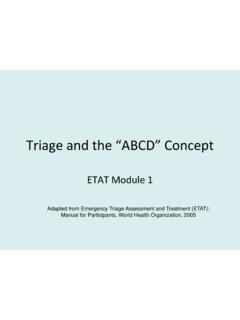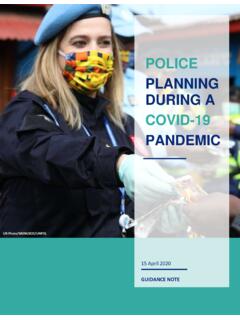Transcription of Appendix B. Tuberculosis (TB) risk assessment worksheet
1 _____ _____ _____ _____ _____ _____ 09/27/2006 Centers for Disease Control and Prevention Division of Tuberculosis Elimination Appendix B. Tuberculosis (TB) risk assessment worksheet This model worksheet should be considered for use in performing TB risk assessments for health-care facilities and nontraditional facility-based settings. Facilities with more than one type of setting will need to apply this table to each setting. Scoring or Y = Yes X or N = No NA = Not Applicable 1. Incidence of TB What is the incidence of TB in your community (county or region served by Community rate_____ the health-care setting), and how does it compare with the state and national State rate _____ average?
2 What is the incidence of TB in your facility and specific settings National rate _____ and how do those rates compare? (Incidence is the number of TB cases in Facility rate your community the previous year. A rate of TB cases per 100,000 persons Department 1 rate _____ should be obtained for comparison.)* This information can be obtained from Department 2 rate _____ the state or local health department. Department 3 rate _____ Are patients with suspected or confirmed TB disease encountered in your Yes No setting (inpatient and outpatient)? If yes, how many patients with suspected and confirmed TB disease are treated in your health-care setting in 1 year (inpatient and outpatient)?
3 Review laboratory data, infection-control records, and databases containing discharge diagnoses. Year No. patients Suspected Confirmed 1 year ago 2 years ago _____ _____ 5 years ago _____ _____ If no, does your health-care setting have a plan for the triage of patients with Yes No suspected or confirmed TB disease? Currently, does your health-care setting have a cluster of persons with Yes No confirmed TB disease that might be a result of ongoing transmission of Mycobacterium Tuberculosis within your setting (inpatient and outpatient)? 2. Risk Classification Inpatient settings How many inpatient beds are in your inpatient setting?
4 How many patients with TB disease are encountered in the inpatient setting in 1 Previous year year? Review laboratory data, infection-control records, and databases 5 years ago _____ containing discharge diagnoses. Depending on the number of beds and TB patients encountered in 1 year, what Low risk is the risk classification for your inpatient setting? (See Appendix C.) Medium risk Potential ongoing transmission Does your health-care setting have a plan for the triage of patients with Yes No suspected or confirmed TB disease? Outpatient settings How many TB patients are evaluated at your outpatient setting in 1 year? Previous year Review laboratory data, infection-control records, and databases containing 5 years ago discharge diagnoses.
5 Is your health-care setting a TB clinic? Yes No (If yes, a classification of at least medium risk is recommended.) Does evidence exist that a high incidence of TB disease has been observed in Yes No the community that the health-care setting serves? Does evidence exist of person-to-person transmission of M. Tuberculosis in the Yes No health-care setting? (Use information from case reports. Determine if any tuberculin skin test [TST] or blood assay for M. Tuberculosis [BAMT] conversions have occurred among health-care workers [HCWs]). Does evidence exist that ongoing or unresolved health-care associated Yes No 1 of 7 _____ _____ _____ _____ 09/27/2006 Centers for Disease Control and Prevention Division of Tuberculosis Elimination transmission has occurred in the health-care setting (based on case reports)?
6 Is there a high incidence of immunocompromised patients or HCWs in the Yes No health-care setting? Have patients with drug-resistant TB disease been encountered in your health-Yes No care setting within the previous 5 years? Year _____ When was the first time a risk classification was done for your health-care setting? Considering the items above, would your health-care setting need a higher risk Yes No classification? Depending on the number of TB patients evaluated in 1 year, what is the risk Low risk classification for your outpatient setting? (See Appendix C) Medium risk Potential ongoing transmission Does your health-care setting have a plan for the triage of patients with Yes No suspected or confirmed TB disease?
7 Nontraditional facility-based settings How many TB patients are encountered at your setting in 1 year? Previous year 5 years ago Does evidence exist that a high incidence of TB disease has been observed in Yes No the community that the setting serves? Does evidence exist of person-to-person transmission of M. Tuberculosis in the Yes No setting? Have any recent TST or BAMT conversions occurred among staff or clients? Yes No Is there a high incidence of immunocompromised patients or HCWs in the Yes No setting? Have patients with drug-resistant TB disease been encountered in your health-Yes No care setting within the previous 5 years? Year When was the first time a risk classification was done for your setting?
8 Considering the items above, would your setting require a higher risk Yes No classification? Does your setting have a plan for the triage of patients with suspected or Yes No confirmed TB disease? Depending on the number of patients with TB disease who are encountered in a nontraditional setting in 1 year, what is the risk classification for your setting? (See Appendix C) Low risk Medium risk Potential ongoing transmission 3. Screening of HCWs for M. Tuberculosis Infection Does the health-care setting have a TB screening program for HCWs? If yes, which HCWs are included in the TB screening program? (Check all that apply.) Physicians Mid-level practitioners (nurse practitioners [NP] and physician s assistants [PA]) Nurses Administrators Laboratory workers Respiratory therapists Yes No Janitorial staff Maintenance or engineering staff Transportation staff Dietary staff Receptionists Trainees and students Volunteers Others_____ 2 of 7 _____ _____ _____ 09/27/2006 Centers for Disease Control and Prevention Division of Tuberculosis Elimination Physical therapists Contract staff Construction or renovation workers Service workers Is baseline skin testing performed with two-step TST for HCWs?
9 Yes No Is baseline testing performed with QFT or other BAMT for HCWs? Yes No How frequently are HCWs tested for M. Tuberculosis infection? Are the M. Tuberculosis infection test records maintained for HCWs? Yes No Where are the M. Tuberculosis infection test records for HCWs maintained? Who maintains the records? If the setting has a serial TB screening program for HCWs to test for M. Tuberculosis infection, what are the conversion rates for the previous years? 1 year ago _____ 4 years ago _____ 2 years ago _____ 5 years ago _____ 3 years ago _____ Has the test conversion rate for M. Tuberculosis infection been increasing or decreasing, or has it remained the same over the previous 5 years?
10 (check one) Increasing Decreasing No change Do any areas of the health-care setting ( , waiting rooms or clinics) or any group of HCWs ( , lab workers, emergency department staff, respiratory therapists, and HCWs who attend bronchoscopies) have a test conversion rate for M. Tuberculosis infection that exceeds the health-care setting s annual average? Yes No If yes, list _____ For HCWs who have positive test results for M. Tuberculosis infection and who leave employment at the health setting, are efforts made to communicate test results and recommend follow-up of latent TB infection (LTBI) treatment with the local health department or their primary physician?















